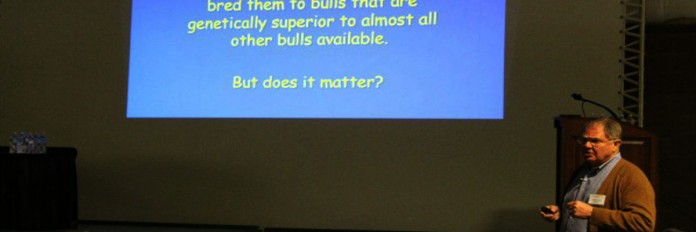DALTON, Ohio — Genetics play a huge role in the success of a confined dairy operation, and they’re equally important to cattle that are grazed.
That was part of the message at the North Central Ohio Grazing Conference for Dairy, held Jan. 22-23 in Dalton.
Bennet Cassell, professor emeritus at Virgina Tech, shared a wealth of knowledge related to genetic testing and improvement for cows that are grazed.
“I suspect you accept that genetics matter, but you’re not, on a daily basis, conscious of how important it is to you,” he said.
“Those cows that you milk every day of your life are the results of years and years of dedicated efforts to specialize that animal for the production of milk.”
But milk is just one of many traits producers should consider. Others include the heifer and cow conception rate, body size, feet and leg composition, daughter pregnancy rate, calving ability and productive life.
Breed wisely
Cassell said it’s a fact of life that dairy cows need to be bred in order to give milk, but producers should choose wisely which bulls are bred to which cows.
“It doesn’t take much more effort … and it doesn’t cost any more if you consider all costs, to use a good bull,” he said. “And you’ll have that calf for her lifetime.”
By definition, genomic testing “combines a laboratory test of tissue from a single animal with prediction equations,” based on the results of tests of older animals and their performance.
Genomic tests are conducted through sponsoring agencies, such as breed associations, AI companies, and Zoetis (formerly Pfizer).
Laboratories evaluate DNA from tissue samples to determine the nucleic acid base at sites distributed throughout the cow’s chromosomes.
A basic test, which is the most affordable, costs $40-$50 and includes about 7,000 test sites.
Producers can get genetic information from the Council on Dairy Cattle Breeding, which includes DHI records, at www.cdcb.us.
Breed to the best
The genetic combinations of potential male to female cow matings are virtually endless, but the principle, Cassell said, is to breed your best cow and heifer to the highest ranking AI bull you can afford. Don’t buy more bull semen than you can use within six months, and make your selections using the most recent proofs available.
The conference, which saw more than 700 on opening day, included a panel of veteran dairy farmers, who talked about their own experience with genetics over the past several years.
Alan Kozak, who operates Clover Patch Jerseys west of Millersburg, Ohio, said his farm tries to breed every cow like they’re going to keep the calf, even though they keep only the best.
He agreed with Cassell that keeping the bull semen current is essential. Kozak said he once used some older semen years ago, and thought he’d save, but ended up with the worst batch of calves he’s had.
Asked what they’d tell younger dairy graziers about genetics, the panelists said to choose proven cattle and avoid cattle that are not yet proven. Also, if you don’t know how to select the best heifers or cows, get help from someone who does.
“The tools are there to evaluate those cattle and to evaluate the sires of our future replacements,” Kozak said. “You either need to learn to use those tools or find somebody you trust to help you.”
Record keeping
Cassell said graziers should at least be in the habit of good record keeping and participating in organizations like DHI, which increases the amount of information available to all dairy producers, so they can improve.
He said genomic testing will only get better, and he expects some breakthroughs in the coming years.
“Genomic testing tells us a great deal and it’s going to tell us more in years to come,” he said.
Other topics
The second day of the conference also addressed topics like urban pressures on farming, small farm resilience, direct marketing and water quality for milk.
Simeon D. Yoder, of Swampcrest Jerseys in Berlin, Pennsylvania, discussed the challenges of farming small-scale, when the farms around him are getting larger and larger, and using modern tractors and farm equipment.
His family has overcome many of these challenges by focusing on non-mechanical agriculture, and direct marketing their products, and way of farming, to consumers.
Gustavo Schuenemann, OSU associate professor and Extension dairy veterinarian, presented the talk Water Quality for Making Milk.
He reminded producers that a cow’s nutritional diet is made up of what it eats, and what it drinks. He showed data of how different water nutrient levels affect cow performance and likelihood of disease.
A mineral imbalance in the water can affect how the cow’s body makes use of other nutrients, and is a critical component to how well she does.
“You need to know the mineral quality in your water,” he said.
Final points
(Bennet Cassell spent 28 years as Extension dairy geneticist at Virginia Tech and currently serves as dairy science professor emeritus. He shared the following key points about dairy grazing genetics:)
• The value of genomic testing is greatest for herds on performance testing with good identification records.
• Genomic testing works best for herds using AI because the sires, maternal grandsires and some of the dams involved have well-established estimates of genetic merit for genetic prediction. Natural service bulls, on the other hand, are at least one generation removed from those ties.
•Genomics is not free. Testing fees will be in the range of $40-$50 per animal. This won’t appeal to low input herds, and can’t be justified in any herd unless the herd manager acts on the test results to reduce costs or increase income.
• No herd will receive a bill for not using good genetic practices. Instead, the loss is the lost opportunity to profit from more productive cattle.
• Most of the potential gain comes in deciding to use carefully selected AI bulls and in basing selection decisions on the best estimates of genetic merit available.
• Breed all cows and heifers on the farm to AI bulls selected for high rank on an appropriate selection index for your herd, using the most recent proofs published.
• Technology changes and so should dairy producers. Genomic testing offers opportunities, even for grass-based herds. Expect more changes in the years to come.











